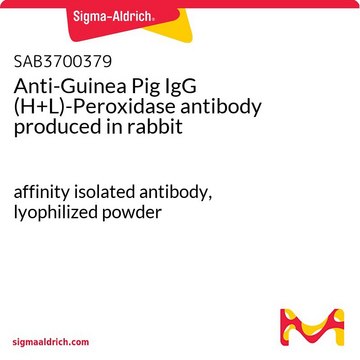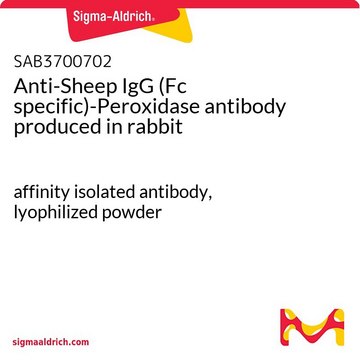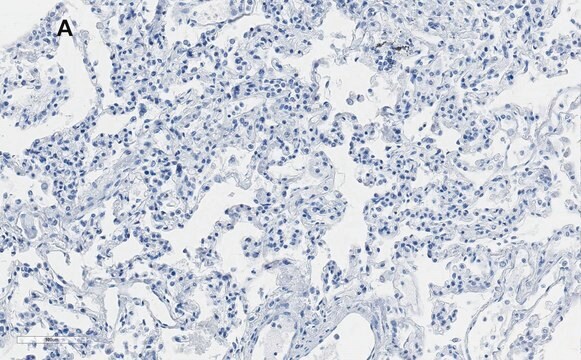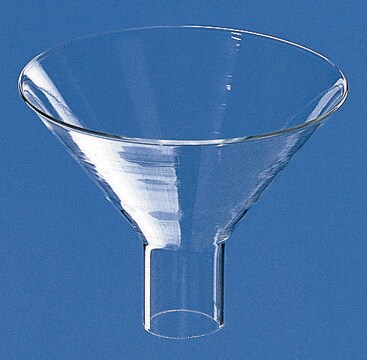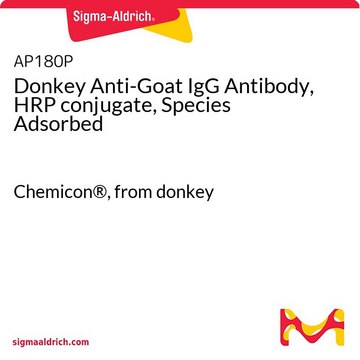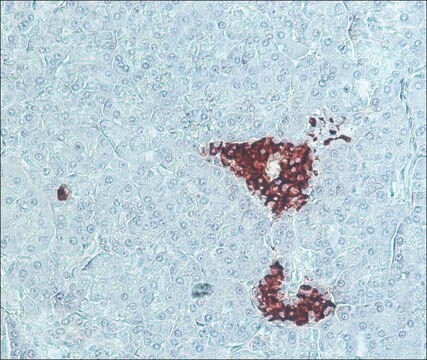SAB3700372
Anti-Guinea Pig IgG (H+L)-Peroxidase antibody produced in goat
affinity isolated antibody, lyophilized powder
Synonym(s):
HRP
Sign Into View Organizational & Contract Pricing
All Photos(1)
About This Item
UNSPSC Code:
12352203
NACRES:
NA.46
Recommended Products
biological source
goat
Quality Level
conjugate
peroxidase conjugate
antibody form
affinity isolated antibody
antibody product type
secondary antibodies
clone
polyclonal
form
lyophilized powder
species reactivity
guinea pig
technique(s)
immunohistochemistry: suitable
indirect ELISA: suitable
western blot: suitable
shipped in
wet ice
storage temp.
2-8°C
target post-translational modification
unmodified
Related Categories
General description
The IgG (immunoglobulin G) structure possesses four polypeptide chains containing two identical γ heavy (H) chains and two identical κ or λ light (L) chains of 50kDa and 25kDa respectively. The chains are interlinked with a disulfide bond. Both the L and the H chains consist of a variable domain at the N-terminal. The C-terminal bears′ constant domains: three in H chain with a hinge region and one in the L chain. IgG contributes to 10−20% of plasma protein and is regarded as one of the most abundant serum protein. IgG antibody is enriched in mother′s milk.
Specificity
This product was prepared from monospecific antiserum by immunoaffinity chromatography using Guinea Pig IgG coupled to agarose beads followed by solid phase adsorption(s) to remove any unwanted reactivities. Assay by immunoelectrophoresis resulted in a single precipitin arc against Anti-Peroxidase, Anti-Goat Serum, Guinea Pig IgG and Guinea Pig Serum.
Immunogen
Guinea Pig IgG whole molecule
Biochem/physiol Actions
IgG (immunoglobulin G) antibody protects against bacterial, fungal and viral infections. It helps in opsonization, complement fixation and antibody-dependent cell-mediated cytotoxicity. IgG antibody has its function similar to IgM antibody in complement system activation. IgG participates in hypersensitivity type II and type III. Maternal IgG is transferred to fetus through the placenta that is vital for immune defense of the neonate against infections.
Physical properties
Antibody format: IgG
Physical form
Supplied in 0.02 M Potassium Phosphate, 0.15 M Sodium Chloride, pH 7.2 with 10 mg/mL Bovine Serum Albumin (BSA) - Immunoglobulin and Protease free
Reconstitution
Reconstitute with 1.0 mL deionized water (or equivalent).
Disclaimer
Unless otherwise stated in our catalog or other company documentation accompanying the product(s), our products are intended for research use only and are not to be used for any other purpose, which includes but is not limited to, unauthorized commercial uses, in vitro diagnostic uses, ex vivo or in vivo therapeutic uses or any type of consumption or application to humans or animals.
Not finding the right product?
Try our Product Selector Tool.
Choose from one of the most recent versions:
Certificates of Analysis (COA)
Lot/Batch Number
Don't see the Right Version?
If you require a particular version, you can look up a specific certificate by the Lot or Batch number.
Already Own This Product?
Find documentation for the products that you have recently purchased in the Document Library.
Designing Antibodies, 216-216 (2012)
The Laboratory Rat (2005)
IgG subclasses and allotypes: from structure to effector functions
Vidarsson G, et al.
Frontiers in Immunology, 5(4), 520-520 (2014)
Placental transfer of IgG subclasses in a Japanese population.
Hashira S, et al.
Pediatrics International, 42(4) (2000)
Specific IgG for cat allergens in patients with allergic conjunctivitis.
Miyama A, et al.
International Ophthalmology, 35(4), 575-586 (2015)
Our team of scientists has experience in all areas of research including Life Science, Material Science, Chemical Synthesis, Chromatography, Analytical and many others.
Contact Technical Service